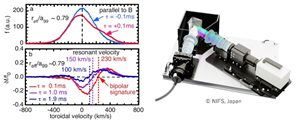ITER NEWSLINE
-
Bouncing dust
DIFFER Press Office

Tracks of different types of dust particles in the plasma beam of Pilot-PSI: small velocity (a) loss to large velocity loss (b) and even sticking. Once a dust particle sticks to the surface, it cools down and is no longer visible. Credit: Andrey Shalpegin et.al.*, Nuclear Fusion
When the hot, dense plasma in a fusion reactor hits the reactor's exhaust wall, dust particles will inevitably erode from the wall and be swept away by the plasma, or ionised gas. But how do these dust particles travel and where do they end up?
An international team has used sensitive cameras to produce the first ever fully resolved movies of dust motion in experiments with DIFFER's linear plasma generator Pilot-PSI (Nieuwegein, The Netherlands). The new data will feed into improved models for dust motion in the fusion reactor ITER.
"Dust particles are a few millionth of a metre (micrometre) in size. A challenge with detecting their minute motions is that you want to have the camera really close to the plasma," says Pilot-PSI operator Kirill Bystrov. In a complete fusion reactor, there is seldom the space to do that—instrumentation ports are too far away from this plasma-surface interaction region. "In Pilot-PSI, we can get the camera within half a metre of where the plasma hits the target."
The experiments reached a record spatial sensitivity of 9 micrometres per pixel. Previous experiments reached 200 micrometres to a few millimetres per pixel - ten to fifty times less sensitive than the record set in Pilot-PSI. This gives unparallelled information about how the dust particles roll, skip and bounce, and how they are influenced by the constant wind of plasma particles. This information will feed into predictive models for the dust motion, to clear up where it will collect and which reactor areas need special focus when cleaning.
The new measurements managed to clear up a mysterious form of motion where a dust speck kept its high temperature while sliding across a cooled surface. Intuitively, that just cannot happen: the particle should cool down to the surface temperature if it is in constant contact. It turns out the 200 micrometre per pixel resolution of the original measurements was to blame - where they saw a particle rolling or sliding in constant contact with the cooled surface, the more accurate 9 micrometre video clearly shows the dust speck bouncing across the surface and only cooling down a fraction when it strikes the surface between bounces.
Read the full report on the DIFFER website.
return to the latest published articles







